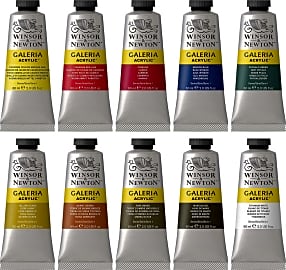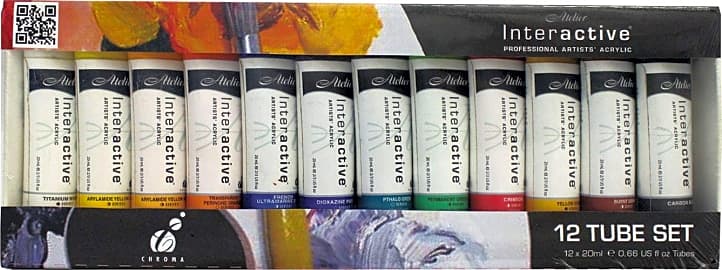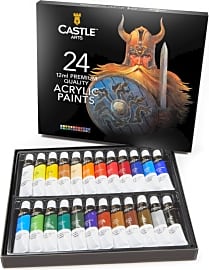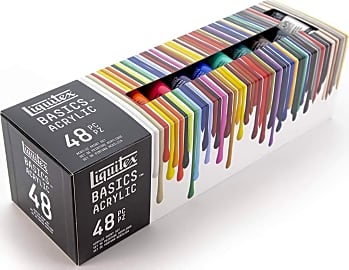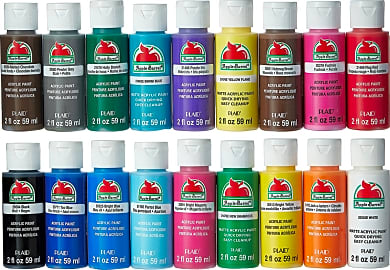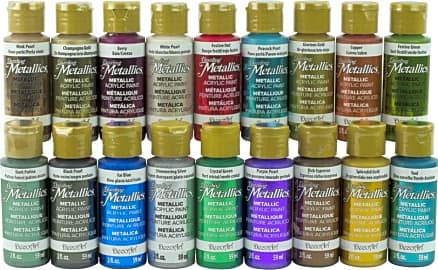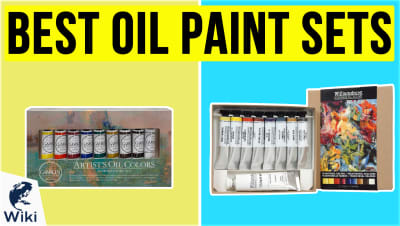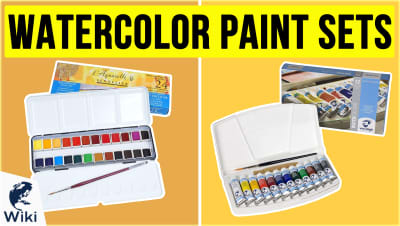The 10 Best Acrylic Paint Sets

This wiki has been updated 36 times since it was first published in February of 2016. Whether you're used to working with watercolors or oils and want to try out a new medium or you'd like to inspire a young artist to begin exercising his or her creative skills, these acrylic paint sets are a perfect choice. They're also great for arts and crafts enthusiasts, as they're capable of decorating wood, glass, clay, ceramics, fabrics, miniature figurines, and much more. When users buy our independently chosen editorial selections, we may earn commissions to help fund the Wiki.
Editor's Notes
September 07, 2020:
Painting can be a relaxing hobby whether you're good at it or not, so we've made sure to keep choices for everyone, from novice to pro. We've removed The Essentials by Twinkleverse at this time, due to ongoing availability issues; newbies will want to take a look at the Castle Art Supplies or the Creative Joy 12, instead. For a very modest investment, these sets put a range of colors in your hands, and the Creative Joy set even comes with brushes, to boot. If you're going to be finishing various arts and crafts projects, the Plaid Apple Barrel 18-Piece or the DecoArt Americana Dazzling Metallics will suffice. They can be applied evenly to a range of surfaces, although you'll probably need at least a couple of coats to avoid any thin spots.
As for higher-end choices, the Golden High Flow Assorted and the Winsor & Newton Galeria are still fine options, and we've added the Chroma Atelier Interactive for those who need more versatility. Unlike other choices, these paints allow for reactivation, which makes it possible to blend them like oil paints. You'll get 12 tubes in this set, but there are plenty more colors available for separate purchase in the range.
May 22, 2019:
At this time, top names in acrylic paints still include Winsor & Newton, Golden, and Liquitex, with each making sets worthy of experienced painters and craftspeople. If you're just getting started, the Liquitex Basics is especially useful; it offers a fine array of colors for a relatively low price, so you don't need to mortgage your house just to take up a new hobby. They also offer smaller sets, so you can replenish your stash easily. For those who are under heavy budget constraints, we still like The Essentials by Twinkleverse or the Creative Joy 12. These are not as richly pigmented as many professional quality sets, but for dabblers, they should be just fine. For those just starting out but with serious intentions, we added the Grumbacher Academy, a 6-piece set that is commonly chosen by students. They mix well, offer good lightfastness, and come in high-quality tubes, all for a moderate price. Finally, we decided to keep the DecoArt Americana Dazzling Metallics. It offers shimmering colors that can bring a project to life, but you may need to use a primer and/or multiple coats to avoid a thin look.
Special Honors
Da Vinci Artists' Colors A set of Da Vinci Artists' Colors lives up to its name by offering six colors that are perfect for mixing, including Red Rose Deep, Cadmium Yellow Light, and Ultramarine Blue. Each set is produced in the USA, to high quality standards, and offers generous 21-milliliter tubes. davincipaints.com
Utrecht Deluxe Easel Set With the Utrecht Deluxe Easel Set, you get much more than a handful of paints; this kit includes four brushes, a palette, and a trowel-shaped palette knife, as well as a hand-oiled wood box for storage and an aluminum easel. Even better, the easel can collapse down to just 26 inches tall, and slip easily into the vinyl carrying bag for transport. utrechtart.com
Chromacryl Set of 6 Primary Colors The Chromacryl Set of 6 Primary Colors is available in either pints or half-gallons, for a relatively budget-friendly price, making this a go-to for many art teachers. As the name suggests, you get the three primary colors, as well as green, black, and white, all of which have a rich consistency and reliably intense color. dickblick.com
Brush With Greatness: The Ideal Acrylic Paint Set
Look no further than Warhol's soup cans or images of Marilyn Monroe for iconic examples.
Acrylic paint has only been in widespread use since the middle of the 20th century. In fact, the paint was not even developed until the mid 1930s and has only existed in a useable form since the late 1940s. And when first released, it was intended for use as a house paint. The audacious artists of the day quickly adopted the bright, quick-drying paint for use in their works, however, and some of the most iconic artwork from the 1900s was wrought in vibrant acrylics. Look no further than Warhol's soup cans or images of Marilyn Monroe for iconic examples.
Though still relatively new to the art scene, acrylic paint has a number of positive attributes worth mentioning in detail. When it comes time to choose the right acrylic paints for yourself, you need worry less about the brief but bright history of this medium and instead focus on what comes in a given set of paints. Many acrylic paint sets will fit the budget of almost any artist. This low price is but one of the reasons acrylic is the ideal paint for exploration. Simply put, the artist can afford to waste this paint.
However, many of the higher priced sets that contain those dozens of tubes of paint actually do their owners a disservice, offering too little of each color for genuine experimentation. A better idea is often to buy a set with fewer different colors of paint but with larger amounts of the colors they do offer. That allows for liberal blending and mixing of colors, letting the artist create her own specific hues rather than painstakingly squeezing out the last drops of paint from a too-small tube. If you are comfortable with this approach, do be certain that any paints you choose come with a copious supply of black and white, and consider buying separate portions of these critical colors.
Most acrylic paints are bright and vibrant, and indeed that is what many artists prize about them. Still, there are options available with more muted tones that lend themselves to landscapes, en plein air painting, and other such types of works. If that is the type of art you hope to create, then a larger set with myriad shades of colors might be a better set than one with larger volumes but limited variety. These sets can help you find a shade close to what you need that can then be "softened" with the addition of some white or gray paint, meaning less time worrying about creating a perfect color and more time painting the scene you see before your eyes.
Why Acrylic Might Be the Best Possible Paint
Any experienced painter will tell you that blending your own colors is a must if you want to achieve just the right look in your artwork. Indeed the most important colors of paint in your set are likely to be black and white, for these are the paints that allow you to create shades and tints, respectively (in color theory, these are technical terms, with the addition of black to another color resulting in a shade and white creating a tint). As noted, the low cost of acrylic paint allows for plenty of experimentation (also known as trial and error) as you seek the perfect shades and tints for your works.
Acrylic paint also has another notable benefit when compared to more traditional media like oil paint or watercolors: it is very fast-drying.
Acrylic paint also has another notable benefit when compared to more traditional media like oil paint or watercolors: it is very fast-drying. Many acrylic paints will be fully dried within hours of application, in fact, while some oil paint can remain technically fluid for months before it is fully dried. (Layers of acrylic can even be applied over still-wet paint without affecting the appearance of the top layer in most cases.)
And unlike finicky (though lovely) watercolors, the viscosity of acrylic paint almost fully precludes its dripping or running, so handling the paint is easy. This makes it an ideal medium for newer painters not yet skilled with brushwork.
Acrylic paint can also be applied to almost any surface, from canvas to terra cotta to plastic and more. While watercolors will refuse to bond with many materials, and oil paints will adhere poorly to many non-porous surfaces, acrylic paints will readily adhere to many different materials, allowing for the adornment of everything from a wall in the home to a section of panel to a decorative planter.
The Science Behind Acrylic Paint
Anyone who knows that many plastics can also be referred to as acrylics will not be surprised to learn that this paint is very much a manmade product created thanks to scientific advances. The base compound used in acrylic plastics and paints is an acrylic resin, itself derived from acrylic acid, which is produced using propylene, a byproduct created by gasoline production. It quickly becomes clear that acrylic paint is something of a happy accident, then; no one set out to produce a new category of paints and plastics, but their potential was quickly identified as other compounds and products were better understood.
Thanks to the base suspension of acrylic paint being an artificial "polymer emulsion," once dried, the paint is highly impervious to water solubility. That makes acrylic paint durable in a way that watercolors and most oil paints are not. However, acrylic paint can still be thinned using water (or other materials) while it is still in liquid form.
Once dried, acrylic paint is impressively resistant to the cracking and flaking common with aging oil paint. (Recall that it was originally developed both for interior and exterior residential and commercial painting.) This resilience only adds to the appeal of the medium, making it suitable for use even in locations where the conditions cannot be guaranteed to be kept perfectly stable.


